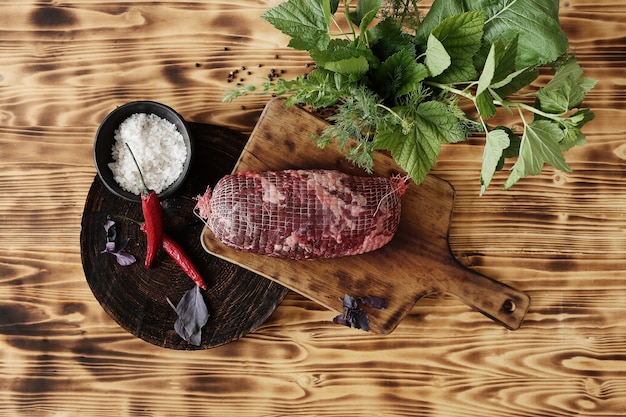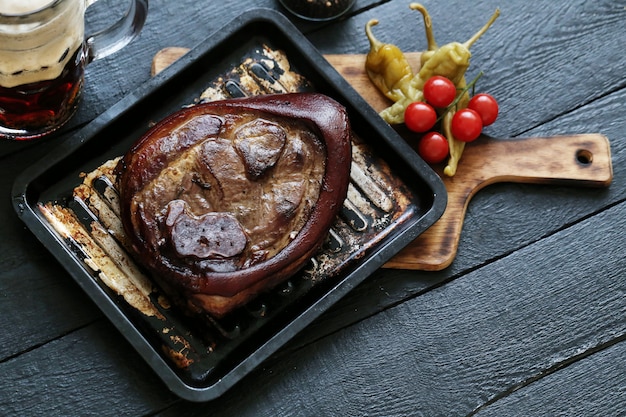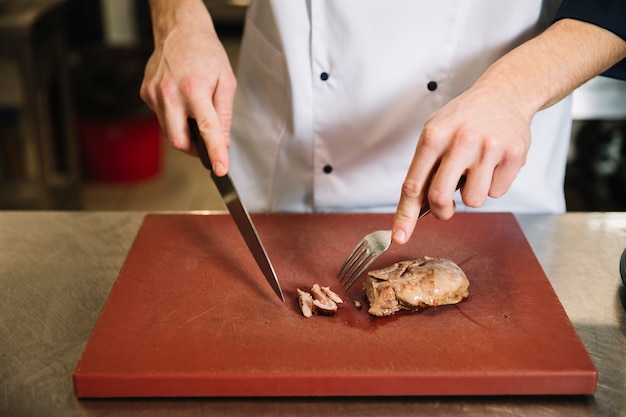Let's be honest, there's nothing quite like a perfectly cooked steak. The juicy tenderness, the rich flavour, that satisfying sizzle – it's a culinary experience that never gets old. But when it comes to round eye steak, a cut known for being a bit tougher than its pricier counterparts, achieving that "melt-in-your-mouth" perfection can feel like a culinary quest.
Well, fear not, fellow steak enthusiasts! Over the years, I've spent countless hours in the kitchen, experimenting with different methods, temperatures, and even the occasional daring marinade to conquer the challenge of round eye. And let me tell you, I've learned a thing or two. This comprehensive guide, filled with my personal experiences and tips, will walk you through everything you need to know to transform this humble cut into a culinary masterpiece.
(Part 1) choosing the right cut: The Foundation of a Great Steak

It all starts with the right cut. You wouldn't build a house on shaky foundations, and the same applies to your steak. Choosing the right piece of round eye is the first step toward a truly delicious meal.
The Meat: Looking for Marbling
When you're at the butcher's counter, look for a round eye steak that's nicely marbled. This means it has streaks of fat running through the lean meat. Don't be afraid of fat – it's your friend! Fat adds flavour, juiciness, and tenderness. Think of it like a natural seasoning that melts and infuses the meat with its goodness. So, avoid any cuts that look dry, pale, or lack that gorgeous marbling. You want a steak that has a good balance of lean meat and fat for the best possible flavour.
The Thickness: Aim for a Generous Slice
Next, pay attention to the thickness. Aim for a steak that's at least an inch thick, ideally closer to 1.5 inches. Why? A thicker steak gives you more control over the cooking process. It allows for even cooking, making sure the inside reaches the desired doneness while the outside gets a beautiful crust. You’ll be able to achieve a perfect balance of tenderness and sear. Plus, it simply looks more impressive on the plate!
(Part 2) Preparing the Steak: Setting the Stage for Flavor

You've got your perfect round eye steak – now it's time to prepare it for its culinary journey. A few simple steps can make a huge difference in the final flavour.
Patting Dry: Kissing Moisture Goodbye
First things first, pat the steak dry with paper towels. This might seem like a trivial detail, but it's a crucial step. You want to remove any excess moisture on the surface, as it can create steam during cooking and prevent a nice, crisp crust from forming. That sear is what adds a layer of flavour and textural delight to your steak.
Seasoning: The Art of Enhancing
Now for the seasoning. I'm a firm believer in keeping it simple – salt and pepper are your best friends when it comes to highlighting the natural flavour of the steak. Just a generous sprinkle of each, making sure to season both sides evenly. If you're feeling adventurous, you can add a pinch of garlic powder or onion powder, but remember, you want to enhance the flavour, not overwhelm it.
(Part 3) Cooking the Steak: The Grill Method – Embracing the Smoky Charm

For me, grilling is the ultimate way to cook a round eye steak. It imparts a delicious smoky flavour and a beautiful char that simply can't be replicated in a pan.
Heating the Grill: Setting the Stage
Start by preheating your grill to high heat – around 500°F (260°C). The goal here is to create a fierce, fiery environment that sears the steak quickly, locking in those precious juices and creating a crispy, flavourful crust.
Grilling Time: A Quick Kiss of Heat
Place the steak on the hot grill and cook for about 2-3 minutes per side. You'll see those gorgeous grill marks start to appear – that's the sign of a perfect sear. It's all about a quick, intense kiss of heat.
Reducing the Heat: Slowing Down for Tenderness
Once you've seared both sides, reduce the heat to medium-low and continue cooking. The goal is to cook the steak through to your desired level of doneness, allowing the internal temperature to rise gently. This is where patience comes in – take your time and don't rush it.
Resting: A Moment of Relaxation
Once the steak is cooked to your liking, remove it from the grill and let it rest for 5-10 minutes before slicing and serving. This might seem unnecessary, but trust me – it's essential! Resting allows the juices to redistribute throughout the steak, resulting in a more tender, flavourful bite. You'll notice a difference.
(Part 4) Cooking the Steak: The Pan-Searing Method – Achieving a Gorgeous Crust Without the Grill
Don't have a grill? No problem! You can still achieve a delicious, perfectly seared steak using the trusty pan-searing method.
Heating the Pan: The Importance of a Hot Pan
Start by heating a heavy-bottomed pan over high heat. Cast iron is your best friend here, as it retains heat incredibly well, ensuring an even, consistent sear. Add a tablespoon or two of oil to the pan and let it heat up until it shimmers – that’s your cue that it’s ready.
Searing the Steak: A Dance of Heat and Flavor
Once the oil is shimmering hot, carefully add the steak to the pan. You'll hear a satisfying sizzle as the steak hits the heat. Cook for about 2-3 minutes per side, ensuring you get a beautiful, even sear. This quick, intense heat creates a delicious crust, locking in those precious juices.
Reducing the Heat: Gentle Cooking to Perfection
After searing, reduce the heat to medium-low and continue cooking the steak to your desired level of doneness. Again, take your time and let the internal temperature rise gently.
Resting: A Crucial Step for Tenderness
Remove the steak from the pan and let it rest for 5-10 minutes before slicing and serving. Resting is essential – it allows the juices to redistribute, making the steak more tender and flavourful.
(Part 5) Achieving Different Levels of Doneness: A Guide to perfect steak
Everyone has their preferred level of doneness. Whether you're a fan of rare, medium-rare, medium, or well-done, knowing the internal temperature is key.
Rare
125°F (52°C) – The centre of the steak will be red and cool to the touch, with a slight give when pressed.
Medium-Rare
130°F (54°C) – The centre will be pink and firm to the touch.
Medium
140°F (60°C) – The centre will be mostly brown with a slight pink hue, and it will feel firm to the touch.
Medium-Well
150°F (66°C) – The centre will be mostly brown, with a few traces of pink, and it will be firm to the touch.
Well-Done
160°F (71°C) – The centre will be completely brown and firm to the touch, with no hint of pink.
Remember, these are just general guidelines. cooking times can vary depending on the thickness of the steak and the heat of your grill or pan. Always check the internal temperature using a meat thermometer for the most accurate results.
(Part 6) Mastering the reverse searing Technique: A Culinary Journey for Extra Tenderness
For a truly exceptional round eye steak that's incredibly tender and juicy, try the reverse searing technique. It's a bit more involved, but the results are well worth the effort.
Low and Slow: A Gentle Rise in Temperature
Preheat your oven to 250°F (120°C). Place the steak on a baking sheet and cook for 30-45 minutes, depending on the thickness of the steak. The idea here is to cook the steak slowly and evenly, ensuring it reaches the desired internal temperature without overcooking.
Searing: Adding That Crispy Touch
Once the steak has reached an internal temperature of about 115°F (46°C) for rare, or 125°F (52°C) for medium-rare, remove it from the oven and sear it on the grill or in a hot pan for 2-3 minutes per side. This creates that delicious, crispy crust you crave, while ensuring the inside is perfectly cooked to your liking.
Resting: Allowing the Flavors to Settle
Let the steak rest for 5-10 minutes before slicing and serving. Resting is essential to allow the juices to redistribute and the steak to relax, making it even more tender and flavourful.
(Part 7) Serving Your Perfect Steak: A Symphony of Flavors and Textures
Your round eye steak is cooked to perfection – now it's time to serve it up and enjoy the fruits of your culinary labour.
Sides: The Perfect Accompaniments
I like to pair my steak with classic sides like creamy mashed potatoes, asparagus roasted to perfection, or a simple green salad. A bit of grilled corn on the cob adds a delightful sweetness, and crispy fries provide a satisfying crunch. The key is to choose sides that complement the flavour of the steak without overpowering it.
Sauces: Adding an Extra Layer of Deliciousness
A good steak sauce can elevate the flavour of your steak to new heights. My personal favourites include chimichurri sauce, with its vibrant herbs and tangy flavour, béarnaise sauce, rich and creamy with a hint of lemony zest, and a simple garlic butter sauce, fragrant and buttery. Feel free to experiment and find your perfect sauce match.
(Part 8) Storing Leftover Steak: Preserving the Flavor for Later
If you happen to have any leftover steak, store it in an airtight container in the refrigerator. It’s best to consume it within 3-4 days.
(Part 9) steak doneness Table: A Quick Reference for Perfect Results
Here's a quick reference table for steak doneness, including internal temperature and approximate cooking times:
| Doneness | Internal Temperature (°F) | Approximate Cooking Time (Minutes) |
|---|---|---|
| Rare | 125-130 | 3-4 |
| Medium-Rare | 130-135 | 4-5 |
| Medium | 140-145 | 5-6 |
| Medium-Well | 150-155 | 6-7 |
| Well-Done | 160-165 | 7-8 |
Remember, these are just general guidelines. Cooking times can vary depending on the thickness of the steak, the heat of your grill or pan, and even the type of cut. Always check the internal temperature using a meat thermometer for the most accurate results.
(Part 10) FAQs: Addressing Your Steak-Related Questions
Q1: What is the best way to tell if a round eye steak is cooked to my desired doneness?
The most accurate way to tell is by using a meat thermometer. Simply insert the thermometer into the thickest part of the steak and check the temperature against the chart provided.
Q2: Can I use round eye steak for other dishes?
Absolutely! Round eye steak is a versatile cut that works well in various dishes. It's great for stir-fries, stews, or even sliced and served in sandwiches. It's a delicious and budget-friendly option that adds flavour and texture to many dishes.
Q3: What are some other tips for cooking a round eye steak?
Here are a few more tips to elevate your round eye steak game:
- Don’t overcrowd the grill or pan. It will make the steak cook unevenly. Give your steaks some space to breathe and cook evenly.
- Don’t pierce the steak with a fork when cooking. This will release the juices and make the steak tougher. Use tongs or a spatula to flip and turn the steak.
- Let the steak rest before slicing. This will allow the juices to redistribute, resulting in a more tender and flavorful steak. Patience is key!
Q4: How long should I marinate a round eye steak?
You can marinate round eye steak for up to 24 hours. However, I generally find that a shorter marinade of 2-4 hours is sufficient. This gives the marinade enough time to infuse the steak with flavour without making it overly mushy.
Q5: Is it okay to freeze round eye steak?
Yes, you can freeze round eye steak. It's best to wrap it tightly in plastic wrap or aluminum foil, and then place it in a freezer-safe bag. Frozen steak can last for up to 3-4 months. Remember, freezing can sometimes affect the texture of the meat, so it's best to use frozen steak for dishes where texture is less critical, like stews or stir-fries.
Remember, everyone's tastes are different, so feel free to experiment with different cooking techniques and seasoning combinations to find your perfect round eye steak. And most importantly, enjoy the process!
Everyone is watching

Corn on the Cob: The Ultimate Guide to Perfectly Cooked Ears
Healthy MealsAh, corn on the cob. Just the name evokes images of sunny days, barbecues, and that sweet, juicy flavour that ...

Perfect Pork Roast Oven Cooking Time: A Guide to Delicious Results
Healthy MealsThere's something truly satisfying about a perfectly roasted pork. The aroma alone is enough to make your mout...

Scallops: The Ultimate Guide to Perfect Cooking
Healthy MealsAh, scallops. Those delicate, sweet, and utterly delicious morsels of the sea. They hold a special place in my...

Spaghetti Squash: The Ultimate Guide to Cooking and Serving
Healthy MealsRemember that time you saw spaghetti squash at the supermarket, looking all bumpy and strange, and thought, "W...

Ham Cooking Time: How Long to Bake, Smoke, or Boil a Delicious Ham
Healthy MealsAh, ham. It's a classic, isn't it? A real crowd-pleaser, especially around holidays. And when done right, it'...
